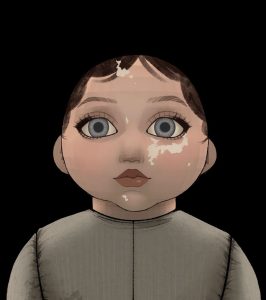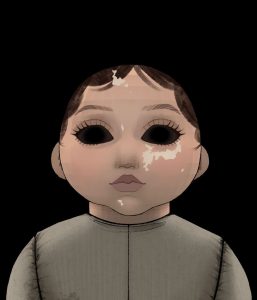I made the base of the dolls as 3D models which I then screenshotted, arranged their parts, and drew over in Procreate. The porcelain hard parts of a doll were sculpted as 3D objects so I could reuse them for a base of all the dolls I would need to make.
In the first two levels, 3 versions of the doll were needed: a full-body view of the doll lying on the Doctor’s work table, a zoomed-in view of the face, and a zoomed-in view of the back of the head. The first level required 3 more versions on top of that because of the phases the doll’s face would go through as the player progressed.



In these levels, the player removes the back of the doll’s skull to access the inside of the head. This basically meant I wasn’t going to be able to do any elaborate hair, all my hair had to be painted on. Which isn’t uncommon for dolls, there were plenty of Victorian examples I looked at that had these lovely luscious ringlets and a good amount of those were wigs, so those ladies tended to be bald underneath. But there were also just baby dolls that had very little hair, just a little tuft painted on at the front of the forehead. I decided to go for a more finger-wave approach for the hair, so the hair looks a mix between a young child and a stylish short haircut.
I will mention though that the eyeballs present in level 1 are not accurate to what real doll eyes look like. For the level, the eyes are rounded, more similar to glass eyes, and that’s because we wanted them to be able to roll around when the player open the draw to collect them. Real doll eyes, specifically the ones that you place yourself in the back of a doll’s head and secure with a paste or gum, are often flat on the back and oblong shaped to fit snugly in the mould of the inside of the doll’s head.
Sam Bedson
